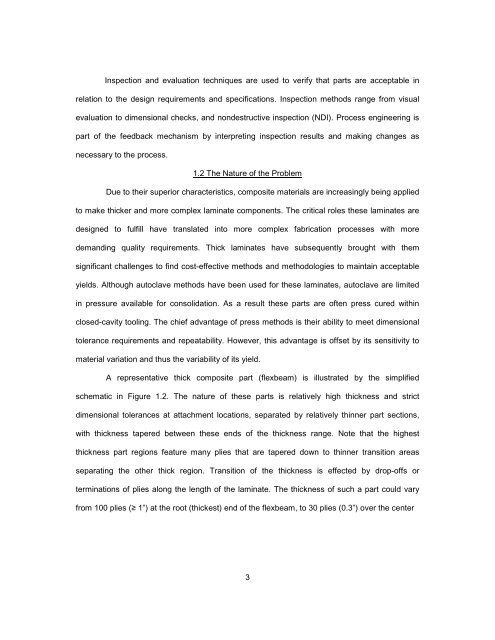TOOLED THICK COMPOSITES by ARVEN H. SAUNDERS III ...
TOOLED THICK COMPOSITES by ARVEN H. SAUNDERS III ...
TOOLED THICK COMPOSITES by ARVEN H. SAUNDERS III ...
You also want an ePaper? Increase the reach of your titles
YUMPU automatically turns print PDFs into web optimized ePapers that Google loves.
Inspection and evaluation techniques are used to verify that parts are acceptable in<br />
relation to the design requirements and specifications. Inspection methods range from visual<br />
evaluation to dimensional checks, and nondestructive inspection (NDI). Process engineering is<br />
part of the feedback mechanism <strong>by</strong> interpreting inspection results and making changes as<br />
necessary to the process.<br />
1.2 The Nature of the Problem<br />
Due to their superior characteristics, composite materials are increasingly being applied<br />
to make thicker and more complex laminate components. The critical roles these laminates are<br />
designed to fulfill have translated into more complex fabrication processes with more<br />
demanding quality requirements. Thick laminates have subsequently brought with them<br />
significant challenges to find cost-effective methods and methodologies to maintain acceptable<br />
yields. Although autoclave methods have been used for these laminates, autoclave are limited<br />
in pressure available for consolidation. As a result these parts are often press cured within<br />
closed-cavity tooling. The chief advantage of press methods is their ability to meet dimensional<br />
tolerance requirements and repeatability. However, this advantage is offset <strong>by</strong> its sensitivity to<br />
material variation and thus the variability of its yield.<br />
A representative thick composite part (flexbeam) is illustrated <strong>by</strong> the simplified<br />
schematic in Figure 1.2. The nature of these parts is relatively high thickness and strict<br />
dimensional tolerances at attachment locations, separated <strong>by</strong> relatively thinner part sections,<br />
with thickness tapered between these ends of the thickness range. Note that the highest<br />
thickness part regions feature many plies that are tapered down to thinner transition areas<br />
separating the other thick region. Transition of the thickness is effected <strong>by</strong> drop-offs or<br />
terminations of plies along the length of the laminate. The thickness of such a part could vary<br />
from 100 plies (≥ 1”) at the root (thickest) end of the flexbeam, to 30 plies (0.3”) over the center<br />
3
















